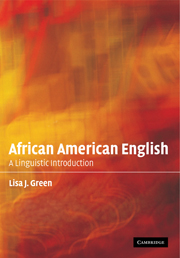Book contents
- Frontmatter
- Contents
- Foreword by John R. Rickford
- Preface
- Introduction
- 1 Lexicons and meaning
- 2 Syntax part 1: verbal markers in AAE
- 3 Syntax part 2: syntactic and morphosyntactic properties in AAE
- 4 Phonology of AAE
- 5 Speech events and rules of interaction in AAE
- 6 AAE in literature
- 7 AAE in the media
- 8 Approaches, attitudes and education
- Endnotes
- References
- Acknowledgments
- Index
- References
References
Published online by Cambridge University Press: 05 June 2012
- Frontmatter
- Contents
- Foreword by John R. Rickford
- Preface
- Introduction
- 1 Lexicons and meaning
- 2 Syntax part 1: verbal markers in AAE
- 3 Syntax part 2: syntactic and morphosyntactic properties in AAE
- 4 Phonology of AAE
- 5 Speech events and rules of interaction in AAE
- 6 AAE in literature
- 7 AAE in the media
- 8 Approaches, attitudes and education
- Endnotes
- References
- Acknowledgments
- Index
- References
- Type
- Chapter
- Information
- African American EnglishA Linguistic Introduction, pp. 255 - 268Publisher: Cambridge University PressPrint publication year: 2002



